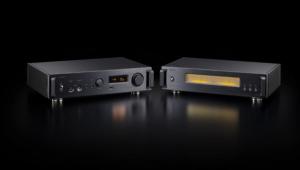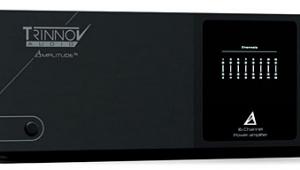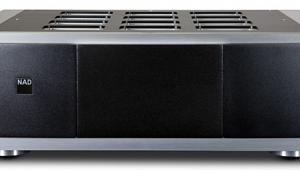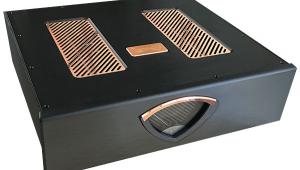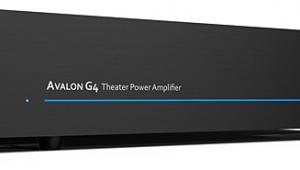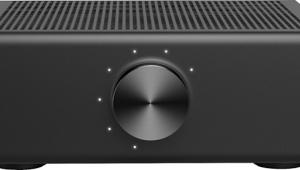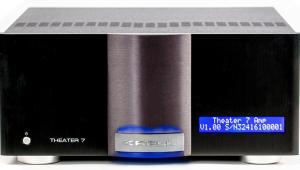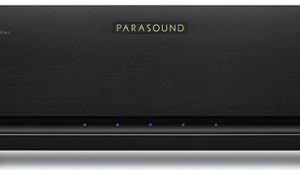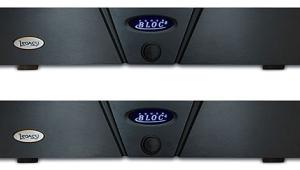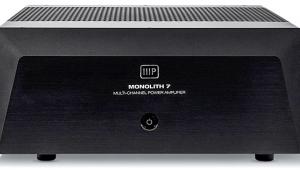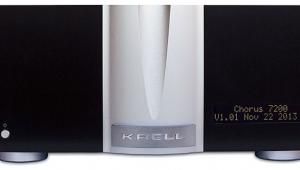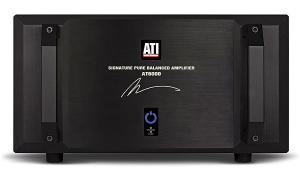Adcom GTP-880 preamp-processor & GFA-7607 multichannel power amplifier Page 2
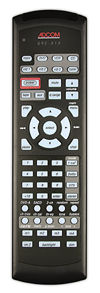 GRC-810 Remote Control
GRC-810 Remote Control
The GRC-810 remote control, included with the GTP-880, is physically well-balanced and intended for right-handed operation—the volume up/down buttons are exactly where the thumb naturally comes to rest. Its black body and pale blue buttons—which glow pleasantly for a few seconds when the backlight button is pushed—echo the GTP-880's look. As with almost all gear on the market today, the remote provides many more functions than do the front-panel buttons. Some of these functions, such as Random, aren't GTP-880 commands at all, but for use with Adcom DVD and CD players. The GRC-810 can also learn commands from other remotes, helping you eliminate clutter on your coffee table. The remote lets you calibrate speaker levels from your normal listening position, but you'll need a sound-pressure level meter, as there is no input on the GTP-880 for a calibration microphone.
The owner's manual claims that the dual-function button labeled Ch Trim and AM/FM on the remote let you toggle between AM and FM when the GTP-880 is in tuner mode, though I was never able to get it to do so. With the tuner on, this button brought up only the Channel Trim function. Likewise, although the dual-function buttons labeled Tone and Bypass are supposed to tune the radio frequency up and down when the tuner is active, I couldn't get them to do this either. I'm not sure if it was operator error, a glitch in the remote, or a mistake in the manual. Apart from controlling tuner functions, everything else on the remote worked as advertised, with intuitive ease.
GTP-880: Performance
I couldn't confirm anything about the tuner's capabilities, other than that it worked, because I live in an area where radio reception is sketchy at best. Radio reception doesn't concern me at all—I hate the hysteria and idiocy of commercial broadcasting, and would never listen to it at home under any circumstances. In the car, it's either my local NPR station for news, or Sirius Satellite Radio for music. Many manufacturers have abandoned AM/FM tuners entirely; Adcom's inclusion of one is a nice touch, but not something that will make or break a sale for a potential home theater customer.
The important thing for home theater fans will be the GTP-880's ease of use and its sound and video quality, all of which I found very good. I noted no degradation of video signals sent through the unit, compared to running a feed directly from my Denon DVD-2900 universal player to my Runco HD-852 projector; the Adcom neither added to nor subtracted from video signals run through it. Not perceptibly, anyway; the bench tests may reveal otherwise. Adcom specifies the 880's video bandwidth at 6MHz for composite and S-video and 100MHz for component. The company claims the processor is compatible with all video formats, including HDTV and scaler signals.
The GTP-880 supports six industry-standard surround modes from Dolby and DTS: Dolby Pro Logic II, Dolby Digital 5.1, DTS, DTS ES Discrete and Matrix, and DTS Neo:6. Each format can be tweaked to some extent using the remote. Adcom provides a Panorama adjustment in Pro Logic II mode that blends some information from the front speakers into the surrounds for what is claimed to be a more enveloping audio experience.
I'm not much for tweaking soundfields, and I am disdainful of the bogus surround modes built into most home theater receivers. Watching films, I pretty much stick with plain-vanilla Dolby Pro Logic II or DD 5.1 and hope that the decoder is doing its job as well as the recording engineers did theirs. If they didn't, however, Adcom's Theater Compensation adjustment tames overly harsh soundtracks. The owner's manual cautions against using Theater Compensation simultaneously with Dolby Pro Logic II's Cinema mode or DTS Neo:6 Cinema because the latter two do something similar. I haven't encountered a DVD that sounded so nasty that I needed to re-EQ its playback. Sometimes I think designers include such features simply because there's room for more code in the DSP engine, and because they can.
One sound-tweaking feature that could promote domestic tranquility is the GTP-880's Dynamic Range Night Mode compensation, which tames the loudest parts of (properly flagged) Dolby Digital soundtracks so that they're less annoying to family members, neighbors, and other, more diurnal creatures. Adcom also offers its own proprietary 7.1m2 surround mode, claimed to "enhance the imaging between the surround speakers" and to create a "more diffuse ambient sound field" by exploiting the rear surround channels. Room-structure limitations, including cables buried in the walls, prevented me from experimenting with anything other than 5.1 applications, so I can't comment on how 7.1m2 performs.
The GTP-880's fundamental sound quality was quite good, offering stable imaging, extended bottom and top ends, and excellent midrange clarity. Its 90dB dynamic range provided all the drive most amps need to go to full output power. With no input but full-on volume, the Adcom GTP-880 was very quiet, an indication of quality engineering and manufacturing. Like the GFA-7607, it wasn't capable of taking me on any magic carpet rides, but I found it quite enjoyable with both music and movies nevertheless.
Two Thumbs Up
One of the longest-running trends in consumer technology is the tendency of luxury features to be trickled down into more affordable products. For example, automatic transmissions and air-conditioning were once found only in the priciest automobiles, but they are now standard features in entry-level vehicles. In home theater gear, once-exotic features such as multiple surround formats, extensive system customization, multichannel amplification, and programmable remote controls are becoming commonplace. All these, and more, are nicely implemented in Adcom's products.
The automotive analogy is overused, but it does provide potential buyers a quick handle on what they're dealing with. The Adcom GTP-880 and GFA-7607 aren't in Lexus territory. They're more like Saturn products—they include as many amenities and as much performance as possible within a price limit, they're very reliable, they're easy and fun to operate, and they'll get you where you want to go with a semblance of panache. Together, the two units can form the heart of a potentially satisfying home theater system.
The Adcoms should be available for about $4000 for the pair. Add speakers, a screen, a midpriced DLP projector, a decent DVD player, and cables to tie it all together, and you should be there for around $15,000—an affordable home-theater system by current standards, and totally respectable. If that's your budgetary ballpark, the Adcoms are absolutely worth checking out. You'll be glad you did.
- Log in or register to post comments
